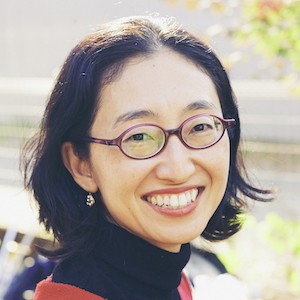Say Translation is Art: Poet and Translator Sawako Nakayasu in Conversation with Professors Susan Bernofsky and Lynn Xu
Literary Translation at Columbia (LTAC), a component of the Columbia University MFA Writing Program, welcomed acclaimed poet and translator Sawako Nakayasu last month for a lecture and discussion.
Born in Yokohama, Japan, Nakayasu moved with her family to the United States at the age of six. She earned an MFA from Brown University. She is the author of several poetry collections, including The Ants (2014), Texture Notes (2010), Hurry Home Honey (2009), and So We Have Been Given Time Or (2004), which was selected for the Verse Prize by Ann Lauterbach. Nakayasu has translated Tatsumi Hijikata’s butoh dance notations, published in Costume en Face (2015); The Collected Poems of Sagawa Chika (2014); Kawata Ayane’s Time of Sky & Castles in the Air (2010), as well as the works of several other authors. Her own work has been translated into several languages, including Swedish, Arabic, Japanese, and Vietnamese.
LTAC hosts semesterly talks with critically acclaimed and beloved practitioners of the art of literary translation. Second-year nonfiction student Odelia Lu had the opportunity to introduce Nakayasu: “Reading Professor Nakayasu’s works is an experience of immersion through the acuteness of her language as well as the strangeness of her images,” Lu said. “They sometimes shed light on urgent discourses such as feminism, racism, immigration, integration, just to list a few. They give you new insights every time you come back to them. Her experimentation subverts conventional forms, not only to convey the beauty of the original language, but also to communicate what it feels like in an overlapped zone between languages, cultures, and histories.”
Nakayasu’s lecture was inspired and informed by her desire to think more expansively about the field and work of translation. “Even as I’m advocating for different and unconventional, marginalized, outsider modes of translation, it’s also not a repudiation of conventional forms of translation, which I also participate in, enjoy, and benefit from,” Nakayasu said. The coexistence of these forms is central to her specific work. While Nakayasu admits she has strong feelings about this subject, she’s not asking others to mimic her approach exactly, but rather open a new area for discussion. “I think it would be ideal if every person develops their own relationship and their own mode of translation based on their own interests, proclivities, values, and concerns.”
As part of her lecture, Nakayasu read and expanded upon selected excerpts from her recent book, Say Translation Is Art (Ugly Duckling, 2020). “I think of this text as something like a map that’s charting the constellation of ideas that are feeding into my thoughts about translation, and where I want translation to spread, “ Nakayasu said. After her lecture Nakayasu was joined by Associate Professor and LTAC Director Susan Bernofsky and Assistant Professor Lynn Xu for a discussion. For Bernofsky, Nakasayu’s work shows how the field of translation is expanding through new kinds of innovation and intersection. Friends and collaborators, Nakayasu and Xu met at the Waldrop’s House, of poet and translators Keith and Rosmarie Waldrop, the legendary founders of Burning Deck Press. Years later, Nakayasu and Xu’s creative paths crossed as Nakayasu worked on editing The Collected Poems of Chika Sagawa for Canarium Books where Xu serves as a co-editor.
During the Q&A portion, one audience member asked Nakayasu to speak more about the anguish of translation, a topic she touched on during her lecture “I think there’s a lot of potential anguish. Part of it can be that sensation of reading and understanding something in the original text and that process and desire of bringing it over to the new place, and not quite being able to bring everything you love about it.” This anxiety of not capturing a piece’s essential elements is a common feeling among translators, Nakayasu noted. Despite these possible sources of anguish, through her collaborative and innovative approach to translation, Nakayasu finds a new kind of freedom to work within.
